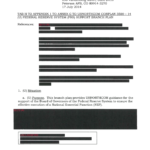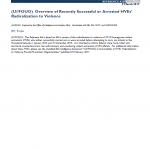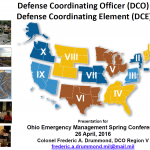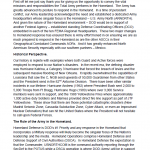
This branch plan provides USNORTHCOM guidance for the support of the Board of Governors of the federal Reserve System to ensure the effective execution of a National Essential Function (NEF).

This Reference Aid is based on I&A’s review of the radicalization to violence of 39 US homegrown violent extremists (HVEs) who either successfully carried out or were arrested before attempting to carry out attacks in the Homeland between 1 January 2015 and 31 December 2016. It is intended to inform federal, state, local, tribal, and territorial counterterrorism, law enforcement, and countering violent extremism (CVE) officials. For additional information about these HVEs, please see the classified I&A Intelligence Assessment “(U//FOUO) Commonalities in HVEs’ Radicalization to Violence Provide Prevention Opportunities,” published 10 February 2017.

On order and in response to natural/manmade incidents, the Defense Coordinating Officer / Defense Coordinating Element (DCO/DCE) anticipates and conducts Defense Support of Civil Authorities (DSCA) operations coordinating Title 10 forces and resources in support of the Federal Primary Agency (PA) in order to minimize impacts to the American people, infrastructure and environment.

Our history is replete with examples where both Guard and Active forces were employed to respond to our Nation’s disasters. In the recent era, the defining disaster was Hurricane Katrina, a Category 3 hurricane that forced the breach of levies and the subsequent massive flooding of New Orleans. It rapidly overwhelmed the capabilities of Louisiana that saw the C, NGB send upwards of 50,000 Guardsmen from other States and the President send in the 82nd Airborne Division. There have been other similar incidents in our lifetime: Hurricane Andrew (1992) where President Bush sent 2,000 to 5,000 Troops from Ft Bragg, Hurricane Hugo (1989) where over 3,000 Service members were sent in support, and the 1988 Yellowstone Fires where approximately 1,000 active duty Soldiers and Marines provided direct fire line support as part of JTF Yellowstone. These show that there are those potential catastrophic disasters (New Madrid Seismic Zone, Cascadia Subduction Zone, Cyber Attack, or even an Improvised Nuclear Detonation) that can hit the United States where the President will not hesitate to call upon Federal Forces.
This bilateral plan provides a framework for military forces of one nation to support military forces of the other nation that are providing military support of civil authorities. The focus of this document is the unique, bilateral military planning considerations required to align our respective national military plans to respond quickly to national requests for military support of civil authorities. Nothing in this plan prevents either nation from responding unilaterally; rather, this plan will facilitate unity of effort, if and when requests for bilateral support are received.
Natural or man-made disasters and special events can be so demanding that local, tribal) state and non-military federal responders are temporarily overwhelmed by the situation. The Department of Defense (DOD) has a long history of supporting civil authorities in the wake of catastrophic events. When directed by the President or the Secretary of Defense (SecDef), United States Northern Command (USNORTHCOM) will respond quickly and effectively to the requests of civil authorities to save livesj prevent human suffering, and mitigate great property damage. The Joint Strategic Capabilities Plan 2008 (JSCP) directs CDRUSNORTHCOM to prepare a plan to support the employment of Title 10 DOD forces providing Defense Support of Civil Authorities (DSCA) in accordance with (IAW) the National Response Framework (NRF), applicable federal law, DOD Directives (DODD), and other policy guidance including those hazards defined by the National Planning Scenarios that are not addressed by other JSCP tasked plans. DSCA is a subset of DOD civil support that is performed within the parameters of the NRF.
The Council of Governors and the President of the United States have identified the need for Dual Status Commanders (DSC) to unify the response efforts within the 54 Territories and States of the United States of America. United States Northern Command (USNORTHCOM) has identified Title 10 Deputy Commanders (O-6 in grade) to lead a Joint Support Force Staff Element (JSF-SE) that will integrate with the State-Level DSC staff in order to provide unity of effort to the response of both Title 32/State Active Duty (SAD) and Title 10 forces. This Standard Operating Procedures document outlines the USNORTHCOM Staff support to the DSC Program, a template for a T10 Deputy Commander Handbook and the methods, procedures and best practices for the JSF-SE.
The North American Aerospace Defense Command (NORAD) and U.S. Northern Command (USNORTHCOM) Publication Series is the authoritative reference defining the Commands’ missions and structure, force employment objectives, mission area planning considerations and operational processes from the strategic to the tactical level. The NORAD and USNORTHCOM Publication Series also defines the Commands’ doctrine, as well as their operational tactics, techniques, and procedures (TTP). The NORAD and USNORTHCOM Publication Series is authoritative because it defines the actions and methods implementing joint doctrine and describes how assigned and attached military forces will be employed in the Commands’ joint and combined operations.
This Study Plan outlines the background, scope, strategic assumptions, study objectives, analysis methodology, scenario considerations, timeline, and management responsibilities in conducting the Homeland Defense and Civil Support Capabilities-based Assessment (HD/CS CBA) to include production of the Functional Area Analysis (FAA), Functional Needs Analysis (FNA) and a Joint Capabilities Document (JCD). This CBA, through the execution of the FAA, FNA. And JCD; identifies, describes, documents, and prioritizes DOD’s capability gaps and excesses in the HD/CS mission areas (to include the Mission Assurance (MA) function).
Preparing Guardsmen to become effective Joint Task Force Commanders (CJTFs) is a critical first step in securing the United States from attack through an active layered defense and responding to a wide range of challenging incidents. Initially, the National Guard Bureau (NGB) designed this course to provide potential CJTFs the knowledge and ability to plan and employ National Guard (NG) Joint Task Forces (JTFs) for homeland defense (HD) and defense support of civil authorities (DSCA). The course has become a partnership between NGB and USNORTHCOM.
This curriculum was directly inspired by the US Marine Corps’ Combat Hunter program. Created in 2007, in response to a dramatic increase in precision fire causalities in Baghdad, Combat Hunter is systematic training designed to improve cognitive skills, showing personnel how to read the human terrain, establish a baseline, detect an anomaly, and make decisions “left of bang.” In other words, Combat Hunter was designed to train personnel to anticipate danger and meet it proactively. In an irregular conflict, this enables personnel to be the “hunters”—not the “hunted.” CODIAC integrates the USMC Combat Hunter principles, along with proven battlefield decision-making and irregular warfare instruction from across the Joint services. The goal of CODIAC is to enhance the ability of individuals and small teams to address irregular challenges by training enhanced observation, battlefield sensemaking, human terrain pattern recognition, and environmental analysis (including knowledge of combat tracking).
Version 3.0 Federal Interagency Geospatial Concept of Operations (GeoCONOPS) final draft from June 2011.
THIS IS ADVANCE WARNING OF AN ANTICIPATED DECISION BY USNORTHCOM PENDING SECDEF APPROVAL TO INCREASE FPCON IN PREPARATION FOR ACTIVITIES COMMEMORATING THE TENTH ANNIVERSARY OF THE 9/11 TERRORIST ATTACKS. WE ANTICIPATE THAT CDRUSNORTHCOM WILL DIRECT CHANGES TO THE FORCE PROTECTION CONDITION (FPCON) LEVELS ACROSS THE USNORTHCOM AREA OF RESPONSIBILITY (AOR). ALL DOD ELEMENTS TACON FOR FP TO USNORTHCOM WILL PLAN FOR EXECUTION OF FPCON LEVEL BRAVO AND IMPLEMENT SUPPLEMENTAL FP ACTIONS, AS DIRECTED HEREIN, NOT LATER THAN 070600Z SEPTEMBER 2011.
This Joint Special Event Threat Assessment (JSETA) addresses potential threats to the National Football League (NFL)USPER Super Bowl XLV, which will be played on 6 February 2011 at Cowboys Stadium in Arlington, Texas. It focuses on potential threats to the game—and to various NFL-sanctioned events scheduled for the Dallas/Ft. Worth Metroplex-area during the 12 days prior to the game—from international and domestic terrorists, cyber actors, criminals, and foreign intelligence services.
(U//FOUO) U.S. Northern Command (NORTHCOM) and CONPLAN 3500 CBRNE Response Overview, March 3, 2009.
The National Security Act of 1947 and title 10 of the United States Code (U.S.C.) provide the basis for the establishment of combatant commands. The Unified Command Plan (UCP) establishes the missions, responsibilities, and geographic areas of responsibility (AORs) for commanders of combatant commands (“combatant commanders”). A “geographic combatant commander” is a commander of a combatant command that includes a geographic AOR. A “functional combatant commander” is a commander of a combatant command with transregional responsibilities. Command of combatant commands will be exercised as provided for herein and as otherwise directed by the Secretary of Defense (the “Secretary”).
USNORTHCOM General Population Evacuation by Air Brief from March 17, 2009.
USNORTHCOM Electric Energy Security in the Domestic Theater brief from December 14, 2009
This smart book was compiled by Joint Task Force North in response to a support request by the United States Border Patrol. The purpose is to provide the Department of Homeland Security with a basic reference and questioning guide to determine the validity of an apprehended individual’s stated country of origin and to assist in identifying those that are Special Interest Aliens (SIAs). Customs and Border Protection identifies thirty-four countries and two territories as special interest countries. This is current as of March 1, 2008.
Sec. 2. Functions. The Council shall meet at the call of the Secretary of Defense or the Co-Chairs of the Council to exchange views, information, or advice with the Secretary of Defense; the Secretary of Homeland Security; the Assistant to the President for Homeland Security and Counterterrorism; the Assistant to the President for Intergovernmental Affairs and Public Engagement; the Assistant Secretary of Defense for Homeland Defense and Americas’ Security Affairs; the Commander,United States Northern Command; the Chief, National Guard Bureau; the Commandant of the Coast Guard; and other appropriate officials of the Department of Homeland Security and the Department of Defense, and appropriate officials of other executive departments or agencies as may be designated by the Secretary of Defense or the Secretary of Homeland Security.Such views, information, or advice shall concern:
(a) matters involving the National Guard of the various States;
(b) homeland defense;
(c) civil support;
(d) synchronization and integration of State and Federal military activities in the United States; and
(e) other matters of mutual interest pertaining toNational Guard, homeland defense, and civil support activities.
The purpose of the Canada-United States Civil Assistance Plan (CAP) is to provide a framework for the military of one nation to provide support to the military of the other nation in the performance of civil support operations (e.g., floods, forest fires, hurricanes, earthquakes, and effects of a terrorist attack).
•DoD is not the Lead Federal Agency
•Provide support only as directed
•Potential missions cover an extremely broad range of activities –anywhere in North America
•Communication interoperability still a nebulous concept
•Strategic, Operational or Tactical?
• NORTHCOM: Initial OPCON and FHP guidance/requirements
• JFMCC: OPCON of Naval assets unless given TACON to JTF-Katrina
• JTF-Katrina: Once stood-up, NORTHCOM gave OPCON to assets in JOA; refine FHP guidance/requirements
In 2002, President Bush signed a new Unified Command Plan (UCP) establishing United States Northern Command (NORTHCOM) to provide command and control of the Department of Defense’s (DOD’s) homeland defense efforts and to coordinate military support to civil authorities.